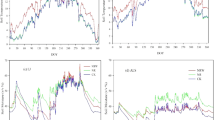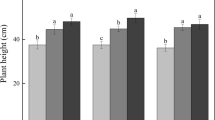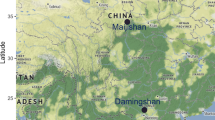Abstract
Background and aim
As global climate change intensifies, the frequency and duration of extreme droughts are predicted to increase, resulting in extended periods of reduced soil water availability across ecosystems. The allocation of carbon (C) to above- and below-ground plant biomass is a fundamental ecosystem property that varies spatially and temporally with water availability. Yet, how extreme drought affects biomass Cpools along an aridity gradient remains poorly understood.
Methods
To elucidate the effects of extreme drought on above- and belowground carbon storage, we conducted a 3-year (2015–2017) precipitation manipulation experiment (66% reduction in growing season precipitation) to simulate a multi-year extreme drought across six grasslands spanning an aridity gradient from desert steppe, typical steppe, and meadow steppe in northern China.
Results
Extreme drought significantly decreased aboveground biomass carbon (AGBC) and litter carbon (LC), but did not affect belowground biomass carbon (BGBC) across the six grasslands. As a result, grassland total carbon (TC) in plant biomass declined overall by ~10%. Across the aridity gradient, drought-induced reductions in AGBC and LC increased with increasing aridity (i.e., reductions were greater in desert steppe than meadow steppe). In contrast, extreme drought increased BGBC in the drier grasslands (desert steppe and typical steppe), but decreased BGBC in the more mesic meadow steppe sites.
Conclusion
We found that extreme drought elicited contrasting responses of plant above- and belowground carbon across an aridity gradient, and that regionally extreme drought will result in a loss of total plant carbon in grasslands dominated by aboveground plant carbon pools.






Similar content being viewed by others
References
Anadon-Rosell A, Hasibeder R, Palacio S et al (2017) Short-term carbon allocation dynamics in subalpine dwarf shrubs and their responses to experimental summer drought. Environ Exp Bot 141:92–102. https://doi.org/10.1016/j.envexpbot.2017.07.006
Atkin O, Bruhn D, Hurry V, Tjoelker M (2005) Evans Review No . 2 - The hot and the cold : Unravelling the variable response of plant respiration to temperature Evans Review No . 2 The hot and the cold : unravelling the variable response of plant respiration to temperature. https://doi.org/10.1071/FP03176
Austin AT, Sala OE (2002) Carbon and nitrogen dynamics across a natural precipitation gradient in Patagonia, Argentina. J Veg Sci 13:351–360. https://doi.org/10.1111/j.1654-1103.2002.tb02059.x
Badeck FW, Tcherkez G, Nogués S et al (2005) Post-photosynthetic fractionation of stable carbon isotopes between plant organs - a widespread phenomenon. Rapid Commun Mass Spectrom 19:1381–1391. https://doi.org/10.1002/rcm.1912
Bai Y, Ianguo JWU, Ing QIX et al (2008) Primary Productio and rain use efficiency across a precipitation gradient on the Mongolia Plateau. Ecology 89:2140–2153. https://doi.org/10.1890/07-0992.1
Bessler H, Temperton VM, Roscher C et al (2009) Aboveground overyielding in grassland mixtures is associated with reduced biomass partitioning to belowground organs. Ecology 90:1520–1530. https://doi.org/10.1890/08-0867.1
Bloor JMG, Bardgett RD (2012) Stability of above-ground and below-ground processes to extreme drought in model grassland ecosystems: interactions with plant species diversity and soil nitrogen availability. Perspect Plant Ecol Evol Syst 14:193–204. https://doi.org/10.1016/j.ppees.2011.12.001
Bowling DR, Pataki DE, Randerson JT (2008) Carbon isotopes in terrestrial ecosystem pools and CO2 fluxes. New Phytol 178:24–40. https://doi.org/10.1111/j.1469-8137.2007.02342.x
Burri S, Sturm P, Prechsl UE et al (2014) The impact of extreme summer drought on the short-term carbon coupling of photosynthesis to soil CO2 efflux in a temperate grassland. Biogeosciences 11:961–975. https://doi.org/10.5194/bg-11-961-2014
Carroll CJW, Slette IJ, Griffin-Nolan RJ et al (2021) Is a drought a drought in grasslands? Productivity responses to different types of drought. Oecologia. https://doi.org/10.1007/s00442-020-04793-8
Chen N, Zhang Y, Zu J et al (2020) Agricultural and Forest meteorology the compensation effects of post-drought regrowth on earlier drought loss across the tibetan plateau grasslands. Agric For Meteorol 281:107822. https://doi.org/10.1016/j.agrformet.2019.107822
Cherwin K, Knapp A (2012) Unexpected patterns of sensitivity to drought in three semi-arid grasslands. Oecologia 169:845–852. https://doi.org/10.1007/s00442-011-2235-2
Ciais P, Reichstein M, Viovy N et al (2005) Europe-wide reduction in primary productivity caused by the heat and drought in 2003. Nature 437:529–533. https://doi.org/10.1038/nature03972
Craine JM, Nippert JB, Elmore AJ et al (2012) Timing of climate variability and grassland productivity. Proc Natl Acad Sci U S A 109:3401–3405. https://doi.org/10.1073/pnas.1118438109
Epstein H, Burke I, Lauenroth W (2002) Regional patterns of decomposition and primary production rates in the production rates in the U.S. Great plain. Ecology 83:320–327. https://doi.org/10.2307/2680016
Fan J, Zhong H, Harris W et al (2008) Carbon storage in the grasslands of China based on field measurements of above- and below-ground biomass. Clim Chang 86:375–396. https://doi.org/10.1007/s10584-007-9316-6
Frank AB, Dugas WA (2001) Carbon dioxide fluxes over a northern , semiarid , mixed-grass prairie. Agric For Meteorol 108:317–326
Frank D, Reichstein M, Bahn M et al (2015) Effects of climate extremes on the terrestrial carbon cycle: concepts, processes and potential future impacts. Glob Chang Biol 21:2861–2880. https://doi.org/10.1111/gcb.12916
Fuchslueger L, Bahn M, Fritz K et al (2014) Experimental drought reduces the transfer of recently fixed plant carbon to soil microbes and alters the bacterial community composition in a mountain meadow. New Phytol 201:916–927. https://doi.org/10.1111/nph.12569
Galvez DA, Landhäusser SM, Tyree MT (2011) Root carbon reserve dynamics in aspen seedlings : does simulated drought induce reserve limitation ? Root carbon reserve dynamics in aspen seedlings : does simulated drought induce reserve limitation ? Tree Physiol 31:250–257. https://doi.org/10.1093/treephys/tpr012
Gilgen AK, Buchmann N (2009) Response of temperate grasslands at different altitudes to simulated summer drought differed but scaled with annual precipitation. Biogeosciences 6:2525–2539. https://doi.org/10.5194/bg-6-2525-2009
Griffin-Nolan RJ, Blumenthal DM, Collins SL et al (2019) Shifts in plant functional composition following long-term drought in grasslands. J Ecol 107:2133–2148. https://doi.org/10.1111/1365-2745.13252
Guo S, Xu Y, He C et al (2019) Differential responses of soil quality in revegetation types to precipitation gradients on the Loess Plateau. Agric For Meteorol 276–277:107622. https://doi.org/10.1016/j.agrformet.2019.107622
Hasibeder R, Fuchslueger L, Richter A, Bahn M (2015) Summer drought alters carbon allocation to roots and root respiration in mountain grassland. New Phytol 205:1117–1127. https://doi.org/10.1111/nph.13146
Heisler-White JL, Knapp AK, Kelly EF (2008) Increasing precipitation event size increases aboveground net primary productivity in a semi-arid grassland. Oecologia 158:129–140. https://doi.org/10.1007/s00442-008-1116-9
Hoover DL, Wilcox KR, Young KE (2018) Experimental droughts with rainout shelters : a methodological review experimental droughts with rainout shelters : a methodological review. Ecosphere 9:1–14. https://doi.org/10.1002/ecs2.2088
Hoovers DA, Rogers BM (2016) Not all droughts are created equal : the impacts of interannual drought pattern and magnitude on grassland carbon cycling. Glob Chang Biol 22:1809–1820. https://doi.org/10.1111/gcb.13161
Hossain ML, Beierkuhnlein C (2018) Enhanced aboveground biomass by increased precipitation in a central European grassland. Ecol Process 7:1–13. https://doi.org/10.1186/s13717-018-0149-1
Hsu J, Powel J, Adler P (2012) Sensitivity of mean annual primary production to precipitation. Glob Chang Biol 18:2246–2255. https://doi.org/10.1111/j.1365-2486.2012.02687.x
Huang B, Fu J (2000) Photosynthesis, respiration, and carbon allocation of two cool-season perennial grasses in response to surface soil drying. Plant Soil 227:17–26. https://doi.org/10.1023/A:1026512212113
Hufkens K, Keenan TF, Flanagan LB et al (2016) Productivity of north American grasslands is increased under future climate scenarios despite rising aridity. Nat Clim 6:710–714. https://doi.org/10.1038/NCLIMATE2942
Jentsch A, Kreyling J, Elmer M et al (2011) Climate extremes initiate ecosystem-regulating functions while maintaining productivity. J Ecol 99:689–702. https://doi.org/10.1111/j.1365-2745.2011.01817.x
Kahmen A, Perner J, Bunchmann N (2005) Diversity-dependent productivity in semi-natural grasslands following climate perturbations. Funct Ecol 19:594–601. https://doi.org/10.1111/j.1365
Knapp A, Huxman TE, Smith MD et al (2004) Convergence across biomes to a common rain-use efficiency convergence across biomes to a common rain-use efficiency. Nature 429:651–654. https://doi.org/10.1038/nature02561
Lauenroth WK, Burke IC, Paruelo JM (2000) Patterns of production and precipitation-use efficiency of winter wheat and native grasslands in the central Great Plains of the United States. Ecosystems 3:344–351. https://doi.org/10.1007/s100210000031
Li X, Zuo X, Yue P et al (2021) Drought of early time in growing season decreases community aboveground biomass, but increases belowground biomass in a desert steppe. BMC Ecol Evol 21:1–13. https://doi.org/10.1186/s12862-021-01842-5
Liu S, Zhang F, Du Y et al (2016) Ecosystem carbon storage in alpine grassland on the Qinghai plateau. PLoS One 11:1–14. https://doi.org/10.1371/journal.pone.0160420
Liu H, Mi Z, Lin L et al (2018) Shifting plant species composition in response to climate change stabilizes grassland primary production. Proc Natl Acad Sci U S A 115:4051–4056. https://doi.org/10.1073/pnas.1700299114
Liu H, Lin L, Wang H et al (2020) Simulating warmer and drier climate increases root production but decreases root decomposition in an alpine grassland on the Tibetan plateau. Plant Soil. https://doi.org/10.1007/s11104-020-04551-y
Luo Y, Su B, Currie WS et al (2004) Progressive nitrogen limitation of ecosystem responses to rising atmospheric carbon dioxide. Bioscience 54:731–739. https://doi.org/10.1641/0006-3568(2004)054[0731:PNLOER]2.0.CO;2
Luo W, Zuo X, Griffin-Nolan RJ et al (2020) Chronic and intense droughts differentially influence grassland carbon-nutrient dynamics along a natural aridity gradient. Plant Soil. https://doi.org/10.1007/s11104-020-04571-8
Ma A, He N, Yu G et al (2016a) Carbon storage in Chinese grassland ecosystems: influence of different integrative methods. Sci Rep 6:1–10. https://doi.org/10.1038/srep21378
Ma X, Huete A, Cleverly J et al (2016b) Drought rapidly diminishes the large net CO2 uptake in 2011 over semi-arid Australia. Sci Rep 6:1–9. https://doi.org/10.1038/srep37747
McCulley RL, Burke IC, Nelson JA et al (2005) Regional patterns in carbon cycling across the Great Plains of North America. Ecosystems 8:106–121. https://doi.org/10.1007/s10021-004-0117-8
Mcsherry ME, Ritchie ME (2013) Effects of grazing on grassland soil carbon: a global review. Glob Chang Biol 19:1347–1357. https://doi.org/10.1111/gcb.12144
Milchunas DG, Lauenroth WK (2001) Belowground primary production by carbon isotope decay and long-term root biomass dynamics. Ecosystems 4:139–150. https://doi.org/10.1007/s100210000064
Muraina TO, Xu C, Yu Q et al (2021) Species asynchrony stabilises productivity under extreme drought across northern China grasslands. J Ecol 109:1665–1675. https://doi.org/10.1111/1365-2745.13587
Ni J (2004) Forage yield-based carbon storage in grasslands of China. Clim Chang 67:237–246. https://doi.org/10.1007/s10584-004-0070-8
Niu S, Wu M, Han Y et al (2008) Water-mediated responses of ecosystem carbon fluxes to climatic change in a temperate steppe. New Phytol 177:209–219. https://doi.org/10.1111/j.1469-8137.2007.02237.x
Novick KA, Stoy PC, Katul GG et al (2004) Carbon dioxide and water vapor exchange in a warm temperate grassland. Oecologia 138:259–274. https://doi.org/10.1007/s00442-003-1388-z
Piao S, Fang J, Zhou L et al (2007) Changes in biomass carbon stocks in China’s grasslands between 1982 and 1999. Glob Biogeochem Cycles 21:1–10. https://doi.org/10.1029/2005GB002634
Raich JW, Russell AE, Kitayama K et al (2006) Temperature influences carbon accumulation in moist tropical forests. Ecology 87:76–87. https://doi.org/10.1890/05-0023
Reichstein M, Ciais P, Papale D et al (2007) Reduction of ecosystem productivity and respiration during the European summer 2003 climate anomaly: a joint flux tower, remote sensing and modelling analysis. Glob Chang Biol 13:634–651. https://doi.org/10.1111/j.1365-2486.2006.01224.x
Saab IN, Sharp RE, Pritchard J, Voetberg GS (1990) Increased endogenous abscisic acid maintains primary root growth and inhibits shoot growth of maize seedlings at low water potentials. Plant Physiol 93:1329–1336. https://doi.org/10.1104/pp.93.4.1329
Sanaullah M, Chabbi A, Rumpel C, Kuzyakov Y (2012) Carbon allocation in grassland communities under drought stress followed by 14C pulse labeling. Soil Biol Biochem 55:132–139. https://doi.org/10.1016/j.soilbio.2012.06.004
Schwinning S, Starr BI, Ehleringer JR (2005) Summer and winter drought in a cold desert ecosystem (Colorado plateau) part II: effects on plant carbon assimilation and growth. J Arid Environ 61:61–78. https://doi.org/10.1016/j.jaridenv.2004.07.013
Scott RL, Jenerette GD, Potts DL, Huxman TE (2009) Effects of seasonal drought on net carbon dioxide exchange from a woody-plant-encroached semiarid grassland. J Geophys Res Biogeosci 114:1–13. https://doi.org/10.1029/2008JG000900
Sherry RA, Weng E, Arnone JA et al (2008) Lagged effects of experimental warming and doubled precipitation on annual and seasonal aboveground biomass production in a tallgrass prairie. Glob Chang Biol 14:2923–2936. https://doi.org/10.1111/j.1365-2486.2008.01703.x
Shi Z, Thomey ML, Mowll W et al (2014) Differential effects of extreme drought on production and respiration: synthesis and modeling analysis. Biogeosciences 11:621–633. https://doi.org/10.5194/bg-11-621-2014
Slette IJ, Post AK, Awad M et al (2019) How ecologists define drought, and why we should do better. Glob Chang Biol 25:3193–3200. https://doi.org/10.1111/gcb.14747
Smith MD (2011) The ecological role of climate extremes: current understanding and future prospects. J Ecol 99:651–655. https://doi.org/10.1111/j.1365-2745.2011.01833.x
Smith MD, Koerner SE, Knapp AK et al (2020) Mass ratio effects underlie ecosystem responses to environmental change. J Ecol 108:855–864. https://doi.org/10.1111/1365-2745.13330
Srivastava K, Jentsch A, Kreyling J et al (2018) Short-term carbon dynamics in a temperate grassland and heathland ecosystem exposed to 104 days of drought followed by irrigation. Isot Environ Health Stud 54:41–62. https://doi.org/10.1080/10256016.2017.1371714
Tardieu F, Davies WJ (1992) Stomatal response to abscisic acid is a function of current plant water status. Plant Physiol 98:540–545. https://doi.org/10.1104/pp.98.2.540
van Heerwaarden LM, Toet S, van Logtestijn RSP, Aerts R (2005) Internal nitrogen dynamics in the Graminoid Molinia caerulea under higher N supply and elevated CO2 concentrations. Plant Soil 277:255–264. https://doi.org/10.1007/s11104-005-7140-1
Wang Y, Jiang Q, Yang Z et al (2015) Effects of water and nitrogen addition on ecosystem carbon exchange in a meadow steppe. 1–16. https://doi.org/10.1371/journal.pone.0127695
Wang Y, Meng B, Zhong S et al (2018) Aboveground biomass and root/shoot ratio regulated drought susceptibility of ecosystem carbon exchange in a meadow steppe. Plant Soil 432:259–272. https://doi.org/10.1007/s11104-018-3790-7
Wang M, Yang W, Wu N et al (2019a) Patterns and drivers of soil carbon stock in southern China’s grasslands. Agric For Meteorol 276–277. https://doi.org/10.1016/j.agrformet.2019.107634
Wang N, Quesada B, **a L et al (2019b) Effects of climate warming on carbon fluxes in grasslands— a global meta-analysis. Glob Chang Biol 25:1839–1851. https://doi.org/10.1111/gcb.14603
Whitney KD, Mudge J, Natvig DO et al (2019) Experimental drought reduces genetic diversity in the grassland foundation species Bouteloua eriopoda. Oecologia 189:1107–1120. https://doi.org/10.1007/s00442-019-04371-7
**a J, Liu S, Liang S et al (2014) Spatio-temporal patterns and climate variables controlling of biomass carbon stock of global grassland ecosystems from 1982 to 2006. Remote Sens 6:1783–1802. https://doi.org/10.3390/rs6031783
Yahdjian L, Sala OE (2002) A rainout shelter design for intercepting different amounts of rainfall. Oecologia 133:95–101. https://doi.org/10.1007/s00442-002-1024-3
Yue K, Fornara D, Yang W et al (2017) Influence of multiple global change drivers on terrestrial carbon storage : additive effects are common. Ecol Lett 20:663–672. https://doi.org/10.1111/ele.12767
Zhang L, Wylie BK, Ji L et al (2011) Upscaling carbon fluxes over the Great Plains grasslands: sinks and sources. J Geophys Res Biogeosci 116. https://doi.org/10.1029/2010JG001504
Zhang B, Tan X, Wang S et al (2017) Asymmetric sensitivity of ecosystem carbon and water processes in response to precipitation change in a semi-arid steppe. Funct Ecol 31:1301–1311. https://doi.org/10.1111/1365-2435.12836
Zhou X, Zhou L, Nie Y et al (2016) Similar responses of soil carbon storage to drought and irrigation in terrestrial ecosystems but with contrasting mechanisms: a meta-analysis. Agric Ecosyst Environ 228:70–81. https://doi.org/10.1016/j.agee.2016.04.030
Acknowledgements
This work was generated using data from the China EDGE Network, supported by the National Key R&D Program of China (2017YFA0604802, 2019YFE0117000) and National Natural Science Foundation of China (31971533, 41320104002). Support was provided to MDS, AKK and SLC by the Konza Prairie Long-term Ecological Research Program, the Drought-Net Research Coordination Network funded by the US National Science Foundation (DEB-1354732) and by the Macrosystems Biology/Emerging Frontiers Programs (EF-1137342, EF-1137378, EF-1137363).
Author information
Authors and Affiliations
Corresponding author
Ethics declarations
Conflict of interest
No conflict of interest was reported by the authors.
Additional information
Responsible Editor: **ao-** **n.
Publisher’s note
Springer Nature remains neutral with regard to jurisdictional claims in published maps and institutional affiliations.
Supplementary Information
ESM 1
(DOCX 328 kb)
Rights and permissions
About this article
Cite this article
Jaman, M.S., Wu, H., Yu, Q. et al. Contrasting responses of plant above and belowground biomass carbon pools to extreme drought in six grasslands spanning an aridity gradient. Plant Soil 473, 167–180 (2022). https://doi.org/10.1007/s11104-021-05258-4
Received:
Accepted:
Published:
Issue Date:
DOI: https://doi.org/10.1007/s11104-021-05258-4




